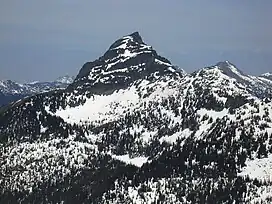| Mount Hatfield | |
|---|---|
 Southwest aspect | |
| Highest point | |
| Elevation | 2,227 m (7,306 ft)[1] |
| Prominence | 266 m (873 ft)[1] |
| Parent peak | Mount Outram (2,461 m)[2] |
| Isolation | 4.29 km (2.67 mi)[1] |
| Listing | Mountains of British Columbia |
| Coordinates | 49°19′37″N 121°10′59″W / 49.32694°N 121.18306°W[3] |
| Naming | |
| Etymology | Harley Hatfield (1905–2000) |
| Geography | |
 Mount Hatfield Location in British Columbia  Mount Hatfield Mount Hatfield (Canada) | |
| Country | Canada |
| Province | British Columbia |
| District | Yale Division Yale Land District |
| Parent range | Hozameen Range Canadian Cascades |
| Topo map | NTS 92H6 Hope |
| Climbing | |
| First ascent | 1956 |
Mount Hatfield is a 2,227-metre (7,306-foot) mountain summit located in the Canadian Cascades of British Columbia, Canada.
Description
Mt. Hatfield is the second-highest summit of Manson Ridge which is a subrange of the Hozameen Range.[1] It is situated 20 km (12 mi) southeast of Hope and 4.2 km (3 mi) north-northwest of Mount Outram which is the nearest higher neighbor.[1] Precipitation runoff from the peak drains into tributaries of the Coquihalla and Nicolum Rivers. Topographic relief is significant as the summit rises 950 metres (3,117 feet) above Kippan Lakes in one kilometre (0.6 mile).
History
The first ascent of the summit was made in 1956 by Roy Mason and Joe Hutton.[4] The mountain's toponym was officially adopted on June 20, 1978, by the Geographical Names Board of Canada.[3][5] The mountain's name was submitted by the Outdoor Recreation Council of British Columbia to honor conservationist Harley Hatfield (1905–2000) of Penticton and his father, Seaman Hatfield (1875–1964).[4][5]
Geology
Mount Hatfield is related to the Chilliwack batholith, which intruded the region 26 to 29 million years ago after the major orogenic episodes in the region. This is part of the Pemberton Volcanic Belt, an eroded volcanic belt that formed as a result of subduction of the Farallon Plate starting 29 million years ago.[6][7]
During the Pleistocene period dating back over two million years ago, glaciation advancing and retreating repeatedly scoured the landscape.[8] The U-shaped cross sections of the river valleys are a result of recent glaciation. Uplift and faulting in combination with glaciation have been the dominant processes which have created the tall peaks and deep valleys of the North Cascades area.
The North Cascades features some of the most rugged topography in the Cascade Range with craggy peaks and ridges, deep glacial valleys, and granite spires. Geological events occurring many years ago created the diverse topography and drastic elevation changes over the Cascade Range leading to various climate differences which lead to vegetation variety defining the ecoregions in this area.
Climate
Most weather fronts originate in the Pacific Ocean, and travel east toward the Cascade Mountains. As fronts approach the North Cascades, they are forced upward by the peaks of the Cascade Range, causing them to drop their moisture in the form of rain or snowfall (orographic lift). As a result, the west side of the North Cascades experiences higher precipitation than the east side. During winter months, weather is usually cloudy, but due to high pressure systems over the Pacific Ocean that intensify during summer months, there is often little or no cloud cover during the summer.[4] As a result, the Cascade Mountains experience high precipitation, especially during the winter months in the form of snowfall. Winter temperatures can drop below −10 °C with wind chill factors below −20 °C. The months of July through September offer the most favorable weather for viewing and climbing Mount Hatfield.
See also
References
- 1 2 3 4 5 "Mount Hatfield, British Columbia". Peakbagger.com. Retrieved 2023-08-19.
- ↑ "Mount Hatfield, Peakvisor.com". Retrieved 2023-08-19.
- 1 2 "Mount Hatfield". Geographical Names Data Base. Natural Resources Canada. Retrieved 2023-08-19.
- 1 2 3 Beckey, Fred W. Cascade Alpine Guide, Climbing and High Routes, Vol. 3, Mountaineers Books (2008), ISBN 9781594854309, p. 250.
- 1 2 "Mount Hatfield". BC Geographical Names. Retrieved 2023-08-19.
- ↑ Cenozoic to Recent plate configurations in the Pacific Basin: Ridge subduction and slab window magmatism in western North America
- ↑ "Miocene peralkaline volcanism in west-central British Columbia – Its temporal and plate-tectonics setting" (PDF). Archived from the original (PDF) on 2011-07-06. Retrieved 2023-08-19.
- ↑ Kruckeberg, Arthur (1991). The Natural History of Puget Sound Country. University of Washington Press.
External links
- Weather forecast: Mount Hatfield
- Harley Hatfield in memoriam: Penticton Herald